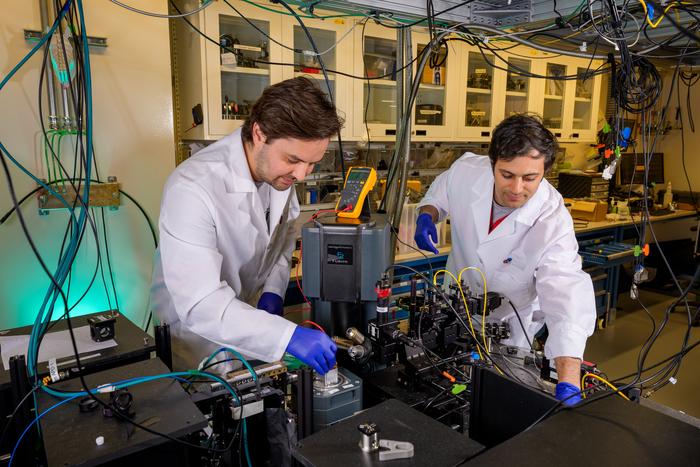Science
New Quantum Biosensor Revolutionizes Biological Monitoring

Researchers at the University of Chicago Pritzker School of Molecular Engineering have developed a groundbreaking optically addressable quantum bit (qubit) encoded in a fluorescent protein. This innovation may serve as a biosensor that can be produced directly within living cells, marking a significant advancement in fluorescence microscopy for monitoring biological processes.
The new qubit technology harnesses the unique properties of quantum bits, which can exist in multiple states simultaneously—unlike classical bits that are limited to a binary state. This ability enables quantum computers to process vast amounts of information at unprecedented speeds, allowing for solutions to complex problems in a fraction of the time it would take traditional computers.
The use of qubits as nanoscale probes allows for high-precision measurement of environmental changes, which is particularly valuable in both physical and life sciences. Current optical qubit sensors are capable of detecting minute changes in magnetic and electric fields, as well as temperature. While these sensors are commonplace in physical sciences, their application in life sciences remains limited, often still in proof-of-concept stages.
Historically, many quantum sensors rely on nitrogen-vacancy (NV) centres in diamonds. These centres, created by replacing two neighboring carbon atoms with a nitrogen atom and a lattice vacancy, act as tiny quantum magnets. When stimulated by laser pulses, they emit fluorescent signals that correspond to local magnetic field changes. As Peter Maurer, who co-led the study with David Awschalom, notes, “The problem is that such sensors are difficult to position at well-defined sites inside living cells.”
In contrast, the researchers have turned to fluorescent proteins, which are merely 3 nanometers in diameter. These proteins can be genetically encoded, allowing scientists to produce sensors at precise locations within cells. This capability has established fluorescent proteins as a “gold standard” in cell biology, with extensive libraries developed through decades of biochemistry research.
Awschalom and Maurer highlighted the similarities between the optical and spin properties of fluorescent proteins and those of diamond-based qubits. They leveraged this insight to combine fluorescence microscopy techniques with quantum control methods to create the new protein-based qubits.
In their study published in Nature, the team successfully used a near-infrared laser pulse to manipulate a yellow fluorescent protein known as EYFP. They achieved impressive results, reading out its triplet spin state with up to 20% spin contrast, as measured through optically detected magnetic resonance (ODMR) spectroscopy. To validate their approach, the researchers genetically modified EYFP, expressing it in both human embryonic kidney cells and Escherichia coli cells, yielding contrast signals of up to 8%.
While this performance does not yet match the capabilities of NV quantum sensors, the potential for magnetic resonance measurements within living cells is a significant leap forward. Maurer emphasized the transformative implications for medical and biochemical studies, stating, “They could thus transform medical and biochemical studies by probing protein folding, monitoring redox states or detecting drug binding at the molecular scale.”
Beyond their sensing capabilities, the unique quantum resonance signatures of these protein qubits open new avenues for fluorescence microscopy. They promise to enhance imaging techniques, enabling highly multiplexed imaging that surpasses current color palettes. Looking to the future, arrays of such protein qubits may allow researchers to explore complex many-body quantum effects within biologically assembled structures.
The research team is actively working to increase the stability and sensitivity of their protein-based qubits through techniques akin to “directed evolution,” which optimized fluorescent proteins for microscopy. They also aim to achieve single-molecule detection, enabling the quantum state readout of individual protein qubits inside cells. Additionally, the team intends to expand the available qubit palette by investigating new fluorescent proteins with enhanced spin properties and developing protocols to detect nuclear magnetic resonance signals from nearby biomolecules.
This innovative work represents a significant step forward in the integration of quantum technology into biological research, with the potential to revolutionize the understanding of complex biological processes.
-

 Health2 months ago
Health2 months agoNeurologist Warns Excessive Use of Supplements Can Harm Brain
-

 Health2 months ago
Health2 months agoFiona Phillips’ Husband Shares Heartfelt Update on Her Alzheimer’s Journey
-

 Science2 weeks ago
Science2 weeks agoBrian Cox Addresses Claims of Alien Probe in 3I/ATLAS Discovery
-

 Science2 weeks ago
Science2 weeks agoNASA Investigates Unusual Comet 3I/ATLAS; New Findings Emerge
-

 Science2 weeks ago
Science2 weeks agoScientists Examine 3I/ATLAS: Alien Artifact or Cosmic Oddity?
-

 Entertainment4 months ago
Entertainment4 months agoKerry Katona Discusses Future Baby Plans and Brian McFadden’s Wedding
-

 Science1 week ago
Science1 week agoNASA Investigates Speedy Object 3I/ATLAS, Sparking Speculation
-

 World2 months ago
World2 months agoCole Palmer’s Cryptic Message to Kobbie Mainoo Following Loan Talks
-

 Entertainment3 months ago
Entertainment3 months agoEmmerdale Faces Tension as Dylan and April’s Lives Hang in the Balance
-

 Science1 week ago
Science1 week agoNASA Scientists Explore Origins of 3I/ATLAS, a Fast-Moving Visitor
-

 Entertainment4 months ago
Entertainment4 months agoLove Island Star Toni Laite’s Mother Expresses Disappointment Over Coupling Decision
-

 Entertainment2 months ago
Entertainment2 months agoMajor Cast Changes at Coronation Street: Exits and Returns in 2025









